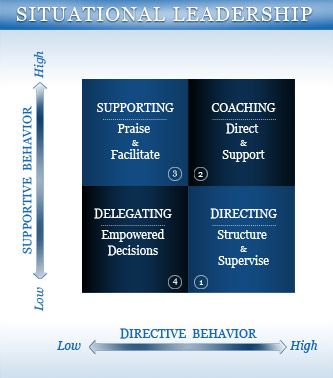
Leadership
Leadership Styles
What’s the best leadership style to have? The good news is there is no one best style. It depends on the situation and the persons social style. We call this “Situational Leadership” combined with the “Task-Specific Readiness” of the individual. We will discuss the four social styles for individuals later.
There are four styles of situational leadership:
- Directing
- Coaching
- Supporting
- Delegating

All of these leadership styles are useful and important. It’s a matter of knowing when to apply the right one. Think about bicycle racing. Cyclists have six main gears on their bike (tools at their discretion) and can pull up any gear depending on the situation on the road. Some gears are completely inappropriate for some terrains. But over the course of a bike race the cyclists probably use most of the gears available to them.
A supporting leadership style is good when you want to get lots of input from people on a subject. It’s not appropriate in an emergency. Asking everyone what door they think should be used in a fire is not useful. Directing leadership is required – get out through this door, now!
Another way of looking at your leadership style is to ask yourself two questions: Am I fast or calm paced? Am I task or people focused? Depending upon your response, you will fall into one of the following categories:
The way to recognize when to use the appropriate leadership style is by the individual’s “task specific readiness”. This means each person has tasks, roles or jobs they have done over and over and are considered very competent. Therefore, when managing this person simply ask them to do it, or let them know “what” you want them to do.
If an employee is new to a role, task or job, they will need coaching, direction and a more hands on approach. They will need to learn from you not just the “what” but the “how”. When introducing a new task or responsibility, a more positive reinforcement and a nurturing coaching style may be necessary. The Task Specific Readiness Managerial Style comes into play when we are asking our people to do new and different tasks. This can be a new employee (low on task specific readiness because they don’t know your company, product, or processes), or a seasoned veteran that you are asking to take on a new challenge, role or task (also low in task specific readiness).
While the task specific readiness style is needed in today’s changing and challenging business environment, it is important to note that many leaders do this instinctively. New managers or weak leaders must learn these styles or risk their employee failing at the task, or worse having a high level readiness employee feeling micro-managed or treated like a child.
The challenge in learning how to lead people is to first identify the social style of each of your employees and then flex and mirror your behavior to communicate your expectations successfully. Strengthening your management style takes time and practice until it becomes second nature.
